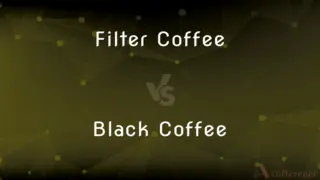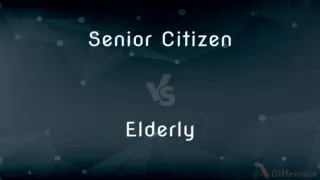Start Codon vs. Stop Codon — What's the Difference?
By Tayyaba Rehman — Published on November 30, 2023
The start codon signals the beginning of protein synthesis, typically "AUG," while stop codons signal its termination, like "UAA," "UAG," or "UGA."

Difference Between Start Codon and Stop Codon
Table of Contents
ADVERTISEMENT
Key Differences
The start codon plays a crucial role in protein synthesis, marking where translation should commence. The stop codon, conversely, indicates where this process should end.
When ribosomes read mRNA during translation, they identify the start codon as the initiation point. The stop codon, on the other hand, instructs ribosomes to release the newly formed polypeptide.
In the genetic code, while there's only one primary start codon, which is "AUG," there are three primary stop codons: "UAA," "UAG," and "UGA."
Interestingly, the start codon not only signals the beginning of translation but also codes for the amino acid methionine. In contrast, stop codons do not code for any amino acid.
As molecular biology evolved, it became evident how crucial these codons are: the start codon ensures accurate protein synthesis initiation, and the stop codon ensures proper termination, preventing unnecessary amino acid additions.
ADVERTISEMENT
Comparison Chart
Function
Initiates protein synthesis
Terminates protein synthesis
Common Codon
AUG
UAA, UAG, UGA
Coded Amino Acid
Methionine
None
Number in Genetic Code
Primarily one
Three
Role in Translation
Signals ribosome to start
Signals ribosome to release polypeptide
Compare with Definitions
Start Codon
Its presence is vital for the accuracy of protein synthesis.
Without the start codon, ribosomes wouldn't know where to begin translating.
Stop Codon
There are three primary stop codons: UAA, UAG, and UGA.
The sequence UGA is one of the three stop codons used in genetic code.
Start Codon
In eukaryotes, the start codon is located at the 5' end of mRNA.
The ribosome scans the mRNA and starts translation once it finds the start codon.
Stop Codon
Their presence ensures the proper termination of translation.
An absence of the stop codon could lead to a dysfunctional protein.
Start Codon
This codon also codes for the amino acid methionine.
When translation begins with the start codon, methionine is the first amino acid added.
Stop Codon
Unlike other codons, stop codons don't code for amino acids.
The protein synthesis halts when a stop codon is reached, and no amino acid is added.
Start Codon
Start codon is the mRNA sequence signaling protein synthesis initiation.
The ribosome recognizes the start codon and begins translation.
Stop Codon
Recognized by release factors in translation.
When a stop codon is read, release factors facilitate the termination of translation.
Start Codon
It is typically represented as "AUG" in mRNA.
In most organisms, AUG serves as the universal start codon.
Stop Codon
Stop codons are mRNA sequences that signal the end of protein synthesis.
When the ribosome encounters a stop codon, it releases the polypeptide chain.
Common Curiosities
Where does the ribosome start translating mRNA?
It starts at the start codon, typically AUG.
Do stop codons code for any amino acid?
No, they don't code for any amino acid.
What is the primary function of the start codon?
It signals the initiation of protein synthesis during translation.
How many stop codons are there?
There are three primary stop codons: UAA, UAG, and UGA.
How does translation terminate?
When a ribosome encounters a stop codon, translation ends.
Is the start codon the same across all organisms?
While there are exceptions, AUG is generally the universal start codon.
Can mutations in the stop codon affect protein synthesis?
Yes, mutations can lead to longer, often nonfunctional proteins.
Does the start codon also represent an amino acid?
Yes, it codes for the amino acid methionine.
Why are stop codons essential?
They ensure proper termination of translation, preventing extended, nonfunctional proteins.
Can stop codons be found in the middle of a gene?
Normally, no. But mutations can introduce premature stop codons, often causing diseases.
Is "AUG" the only start codon?
It's the primary one, but in rare cases, other codons can initiate translation.
What happens if a start codon is mutated?
Protein synthesis might not initiate, leading to nonproduction or misproduction of a protein.
How does the cell "read" the start and stop codons?
Ribosomes "read" these codons during the process of translation.
Are there proteins associated with recognizing the stop codon?
Yes, release factors recognize stop codons and facilitate translation termination.
If the start codon initiates translation, why is it also associated with an amino acid?
It ensures that every protein begins with methionine, which can be essential for protein targeting and other functions.
Share Your Discovery

Previous Comparison
Filter Coffee vs. Black Coffee
Next Comparison
Senior Citizen vs. ElderlyAuthor Spotlight
Written by
Tayyaba RehmanTayyaba Rehman is a distinguished writer, currently serving as a primary contributor to askdifference.com. As a researcher in semantics and etymology, Tayyaba's passion for the complexity of languages and their distinctions has found a perfect home on the platform. Tayyaba delves into the intricacies of language, distinguishing between commonly confused words and phrases, thereby providing clarity for readers worldwide.













































